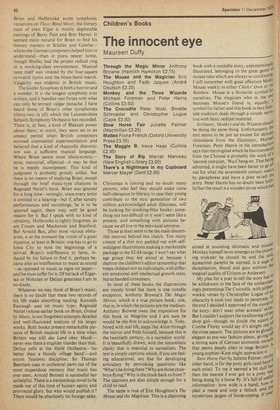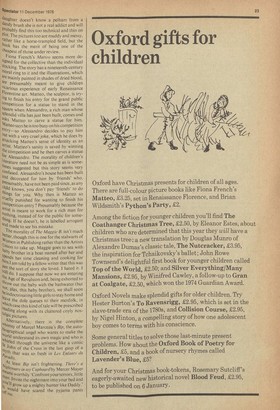The innocent eye
Maureen Duffy
Through the Magic Mirror Anthony Browne (Hamish Hamilton £2.75) The Mouse and the Magician Eric Houghton and Faith Jaques (Andre Deutsch £2.25) Monkey and the Three Wizards Michael Foreman and Peter Harris (Collins £3.50) The Crocodile Peter Nickl, Binette Schroeder and Christopher Logue (Cape £3.50) Stow Horse Fair Juliette Palmer (Macmillan £2.25) Matteo Fiona French (Oxford University Press £3.25) The Maggie B. Irene Haas (Collins £2.95) The Story of Bip Marcel Marceau (New English Library £3.00) There's a Nightmare in my Cupboard Mercer Mayer (Dent £2.50) Christmas is coming and no doubt many parents, who feel they should make some half-obeisance to literacy in case their young contribute to the next generation of two million acknowledged adult illiterates, will be looking for stocking-filler books: something not too difficult or it won't seem like a present, and something with pictures because we all live in the televisual universe.
Those at least seem to be the main discernible motives behind this clutch. Too many consist of a thin text padded out with selfindulgent illustrations making a marketable package in the E2-£4 range. I won't say what age group they are aimed at because deplore the children's editor censorship that treats children not as individuals,with different emotional and intellectual growth rates. but as banded consumers.
In most of these books the illustrations are merely tinsel but there is one notable exception, Anthony Browne's The Magic Mirror, which is a true picture book; one, that is, in which the pictures are the medium. Anthony Browne owes the inspiration for this book to Magritte and I am sure he would be the first to acknowledge it. Toby, bored with real life, steps like Alice through the mirror and finds himself, because this is the twentieth century, in a surrealist world. It is beautifully drawn, with the naturalistic clarity that is essential to surrealism. The text is simply captions which, if you are feeling educational, are fine for developing articulacy by provoking questions like 'What's he doing there ?Why are those choirboys flying ? Why is the clock back to front ?' The captions are also simple enough for a child to read.
The same is true of Eric Houghton's The Mouse and the Magician. This is a charming
book with a readable story, unpretentioush' illustrated, belonging to the great genre 01. mouse tales which are always so comforting, I still remember with great affection Mont) Mouse weekly in either Chicks' Own or the Rainbow. Mouse is a favourite symbol f(); ourselves. The magician who in the en° becomes Mouse's friend is, equally, 3 symbol for father and this book in best fairy' tale tradition deals through a simple narrative with basic oedipal material. In theory, Monkey and the Wizards should be doing the same thing. Unfortunately the text seems to be just an excuse for delicate, chinoiserie from the illustrator, Michae Foreman. Peter Harris in his introduction says that the original which he has translated from the Chinese is probably the work of a 'second-rate poet,' Wu C'heng-en. That being, admitted, it might have been better to go al out for what the seventeenth century meant by paraphrase and have a poet re-tell the story. Peter Harris has no doubt been faith' ful but the result is a wooden prose which has aimed at sounding idiomatic and missed' Monkey himself never emerges as the charny ing trickster he should be and the end; squeamish parents be warned, is a saga 0' decapitation, blood and guts without the magical quality of Grimm or Andersen. n My plea for a poet to tell the story has 1be withdrawn in the face of the embarrass' ingly pretentious The Crocodile, with jabber' wockic verses by Christopher Logue of a° obscurity it took two reads to penetrate. the end I decided I approved of the moral 01 the story: don't wear other animals' skins' But I couldn't support the swallowing of tiler shop girl—though no doubt the squire °f' Combe Florey would say it's alright out the close season. The pictures are as glossnif elegant as pre-war fashion plates, giving °, a strong aura of German economic mirac'e that seems deeply alien in siege Britain. A young sophisti-Kate might appreciate it. Stow Horse Fair by Juliette Palmer, on th,ef other hand, is for the pony girls (and boYs such exist). To me it seemed a bit dull hit, then the nearest I ever got to a pony being stung by a horse fly. It's full of useta'to information: how wide is a hand, how plait a mane and snip a fetlock and th; mysterious jargon of horse-coping. If Y°11 daughter doesn't know a pelham from a dandy brush she is not a real addict and will Probably find this too technical and thin on Plot. The pictures too are muddy and messy, rather like a horse-trampled field, but the hook has the merit of being one of the cheapest of those under review.
Fiona French's Matteo seems more designed for the collective than the individual stocking. The story has a nineteenth-century Moral ring to it and the illustrations, which are mainly painted in shades of dried blood, are presumably meant to give children vicarious experience of early Renaissance Florentine art. Matteo, the sculptor, is trying to finish his entry for the grand public coMpetition for a statue to stand in the square when Alessandro, a rich man whose Splendid villa has just been built, comes and asks Matte() to carve a statue for him. Matteo says he is too busy on his competition entry—so Alessandro decides to pay him out with a very cruel joke, which he does by attacking Matteo's sense of identity as an artist. Matteo's sanity is saved by winning the competition and he then carves a statue 1:91' Alessandro. The morality of children's 'iterature need not be as simple as is sometittles suggested but this story seems very c°ofused. Alessandro's house has been built and decorated for him by 'friends' who, Presumably, have not been paid since, as any child knows, you don't pay 'friends' to do things for you. Why then is Matteo so craellY punished for wanting to finish his et3rriPetition entry? Presumably because the artist is meant to work for a rich man for nothing, instead of for the public for someihing. If he doesn't, he is labelled arrogant and made to see his mistake.
The morality of The Maggie B. isn't much hwetter, though this is one for the stalwarts of u omen in Publishing rather than the Artists b "ion to take up. Maggie goes to sea with abY brother in a boat named after her and sh13.ends her time cleaning and cooking for
• ".I am told by a fellow writer that this was
st the sort of story she loved. I hated it. I stktill do. I suppose that now we are entering I,' Age of Revulsion and, being exhorted to "row out the baby with the bathwater (but 1113cel!, alas, this baby brother), we shall soon le indoctrinating little girls to stay home and
ave the dole queues to their menfolk, in
hieh case this kind of tale will be prescribed leading along with its cluttered coyly nosalgie pictures. whA. Iternatively, there is the complete b. lirlsY of Marcel Marceau's Bip, the auto°graphical angel who wants to make the ;?rld understand its own magic and who is stnirled through the universe like a comic J°1-10 of the Cross in the last gasp of a MYth that was so fresh in Les Enfants du At least Bip isn't frightening. There's a rnightmare in my Cupboard by Mercer Mayer nleans Worthily 'Confront your terrors, little yoan. Invite the nightmare into your bed and It all grow up a mighty hunter like Daddy.' would have scared the pyjama pants off me.



































 Previous page
Previous page